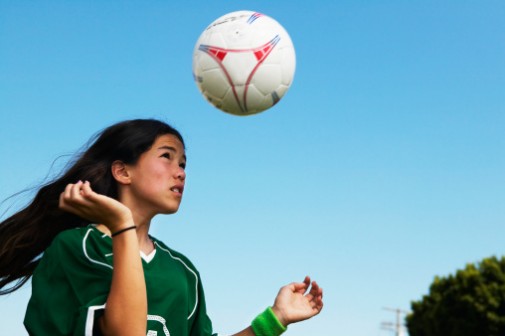Girls tend to ignore concussion symptoms

There is at least one soccer player in 30 percent of U.S. households, and it is the second-most popular sport among 12-24 year olds. With the sport’s explosion, however, emerges a growing danger, especially among girls who play soccer.
A new study published in the Journal of the American Medical Association—Pediatrics has found that concussions are becoming common among middle-school girls who play soccer, and most continue to play symptoms after being diagnosed with a concussion.
The study evaluated the “frequency and duration of concussions” among 351 female soccer players (ages 11 to 14) in Washington, and found that there were 59 incidences of concussions during the study, including eight repeat concussions. Most of these occurred during games either due to collisions with another player or when heading the ball.
Researchers discovered a rate of 1.3 concussions for every 1,000 hours of practice or game time, which was higher than what has been reported in studies of female soccer players at the high school and college levels. Further, concussion symptoms lasted an average of nine days, and less than half of the girls who suffered a concussion sought medical attention. More than 58 percent continued to play with their symptoms, the researchers reported.
“Oftentimes, kids either want to play so badly, they won’t tell parents the truth about how they feel, or they don’t realize that they even have a concussion—especially younger kids,” says Dr. Kathryn Talerico, a pediatrician with Advocate Condell Medical Center in Libertyville, Ill.
Still, Dr. Talerico urges parents to err on the side of caution when it comes to kids and concussions. “Parents have to listen to your child, and pay attention to the signs and symptoms of a concussion. They may not be able to concentrate at school, complain about headaches, be sensitive to bright lights, or may feel nauseous. Younger kids might simply complain that they ‘don’t feel right.’ Regardless, parents need to make sure the child is evaluated by a physician and cleared before they return to the field.”
According to a news release from JAMA, sports-related concussions account for 1.6 to 3.8 million injuries in the United States annually, including about 50,000 soccer-related concussions among high school players. The Centers for Disease Control and Prevention offers this guide for parents of student athletes about concussions.
Related Posts
Comments
About the Author
health enews staff is a group of experienced writers from our Advocate Health Care and Aurora Health Care sites, which also includes freelance or intern writers.

















